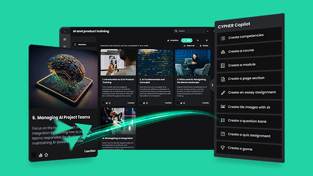Are you happy with how your online class is going?
All teachers will answer this question at one point or another. A low participation rate is usually one of the biggest problems with online classes.
At first, teachers assume that students will gladly participate since they’re the so-called digital natives, and online interaction should come easy to them. In reality, some will flourish, while others will need more help to come out of their shells. Unfortunately, the pandemic school closures didn’t help, as many teachers and students were unprepared for online-only classes.
And even though schools have started to slowly open, it’s still a shaky situation. Some have had to close multiple times, while some are now considering adopting the hybrid class model permanently.
That’s why learning how to engage students online is still a worthwhile endeavor.
Actionable advice to improve participation rates in online classes
Encouraging more students to participate in online classes means giving each one plenty of opportunities to do so and creating the right environment. If you’re feeling stuck right now or want to get them to open up more, here are seven activities to try next:
1. Rapid icebreakers
Starting with the right mindset has a snowball effect, as it encourages students to engage from the beginning. That’s why Icebreakers are fun, but let’s be honest, they can take more time than planned. Rapid icebreakers, on the other hand, can be fitted in a three to a five-minute slot.
Here are some of my personal favorites:
- Shape-shift — ask students to turn off their cameras. They have two minutes to find something to wear as a costume and change their names to reflect their new persona;
- Polls — this is simple since all you have to do is ask a question, such as “How are you feeling today?” and everyone can participate in the poll. It also helps you understand their energy levels and how to switch things up with the other activities;
- Draw your mood — ask them to use the virtual whiteboard to draw their mood;
- High five — ask them to “high five” the classmate to the right, the left, diagonally, etc.
- Never have I ever — post questions on a whiteboard or slide and have students raise their hands for “I have.” For example, a good question can be “I took a long walk this week” or “I petted a dog.”
The goal is for all students to participate, no matter how small this interaction seems.
2. Interactive chats
Students get more opportunities to talk during smaller classes regardless of the format. In online sessions, teachers can ask students to speak if the class size is relatively small or use the chat function if it’s a larger class.
The system is simple. Students raise a hand whenever they have a question, so it’ll be their turn to speak. They can also use emojis to express their understanding of a concept. For example, a smiling face emoji means that everything is clear, and a frowning face means that it needs more explanation. You can also find ways to express, “This lesson is hard.”
The interactive chat is easier to use when you have a TA or someone that can help moderate the chat, but you can do it yourself for shorter Q&A activities.
3. Online show and tell
I find that show-and-tell never gets old since it’s an opportunity for students to talk about themselves and relate to different subjects through their experiences. In this scenario, students get to be the instructor for a while and make this activity as interesting as they want (videos, presentations, collages, etc.).
You can also encourage students to participate by gamifying the process. For example, in one activity, the teacher shows a diagram representing a food chain but without the lines connecting the relevant concepts. In this case, students can work in pairs discussing the connection between the trophic levels and explain their thinking process. They complete the diagram for other students to see.
The idea behind this activity is to encourage students to present, wait for their turn, take the lead, draw on the screen — anything but observe passively.
4. Flipping the classroom
If direct instruction isn’t working just as effectively, it might be time for a change.
The flipped classroom is nothing new, but now more than ever, educators turn to this instructional method to raise engagement levels. They find it easier to teach the content through video or written lessons, which students can access anytime. Then, all the synchronous activities and discussions will rely on student participation, which gives them ownership of the learning process.
If you’re using an LMS, you can also “drip content” to students by scheduling lessons to become available weekly or whenever you need them to. In this way, students won’t skip ahead, focusing on one section at a time.
5. Peer feedback
In most cases, students work individually or in small groups and receive a grade, which is considered enough. However, what if assignments were more interactive? What if they learned to give feedback to one another?
A good example is essay writing, which takes time and practice. Writing a short essay and having another student give feedback also enhances their critical thinking skills and teaches them how to receive feedback on their work.
The above example is an excellent asynchronous activity, but this can also be done during synchronous classes. The teacher offers a prompt, such as “Write an introduction to an essay.” Then, they organize a round of rapid feedback in which students give their opinions based on questions that appear on screen, such as:
What is something that I like about their work?
What could be improved?
What would I do differently?
What did I learn from their work?
This type of exercise is mutually beneficial, and they can come up with great ideas for improvement. Plus, the chances are that most students will remember the points that their colleagues made and use them for future reference.
6. Game of online tag
Tag, you’re it!
The classic game works just as well in the virtual classroom, with a few adjustments. For example, the teacher gives a prompt, and based on that, students take turns answering questions or providing the correct answer. When done, they can nominate someone else to go next. To make it even more fun, they can tag the person in the comments with the @... mention function or write their name/nickname on the virtual whiteboard.
The rule is to tag other people all the time, so everyone has a chance to participate. The biggest benefit is that all students have to pay attention in case they get tagged. This works for any activity type, such as solving Math problems or answering questions about a subject in History class.
7. Online brainstorming
Students need peer interactions just as much as they need teacher-student interaction. An easy activity to counteract this is online brainstorming.
Students can be divided into breakout rooms and use a collaboration tool such as Google docs or Sharepoint. They will have a certain amount of time to brainstorm ideas, research, solve problems, etc. To make sure that each group is on task, you can switch between breakout rooms.
If they need something more versatile for writing ideas or drawing, there’s always the option of collaborative online whiteboards.
Bonus idea: Gathering feedback
While setting expectations is something that you do at the beginning of a class, feedback can be done whenever you need to change something. A low participation rate can be caused by plenty of factors. You need to separate what you can do as an educator and other external factors, such as the need for a better internet connection.
Surveys are the quickest way to gather feedback and identify other problem areas. Plus, if you think that students will be more comfortable giving their opinions through anonymous surveys, why not give it a go? A good idea is to use more multiple-choice questions instead of open-ended ones. For example, ask them to “Rate class activities as a. Very interactive b. Moderately interactive, c. Not interactive at all.”
Students usually receive feedback on their work. Being able to participate and give feedback to the teacher is a welcome change.
Wrapping up
Finding your rhythm as an online teacher is a learning experience, not something that happens overnight.
Classroom management is tricky, and every teacher will find their own style to engage their students. In the meantime, the best thing that you can do is implement new activities that will give each student a chance to participate.







